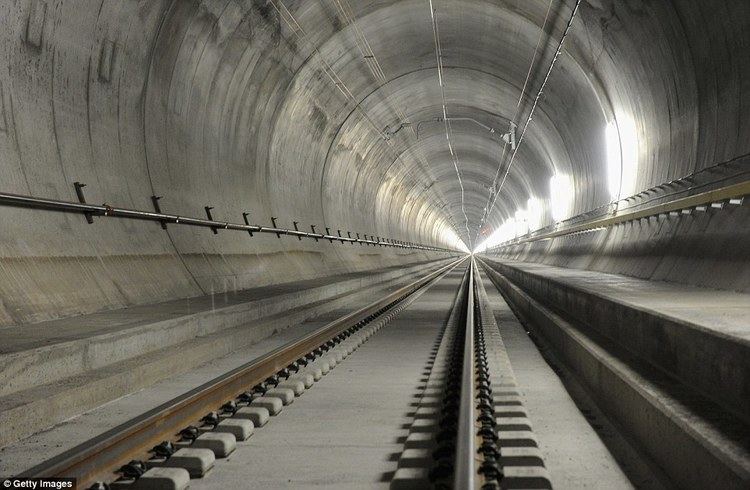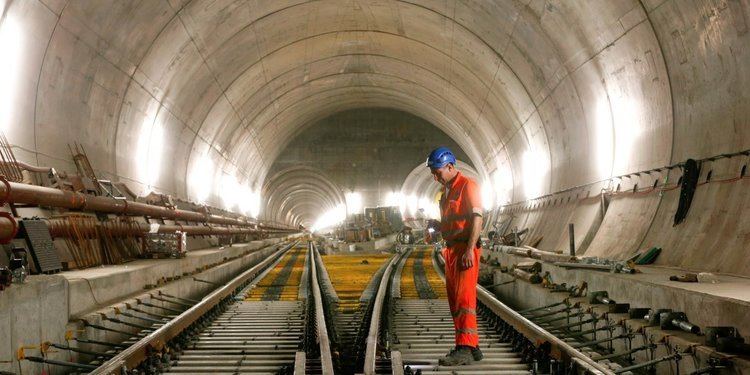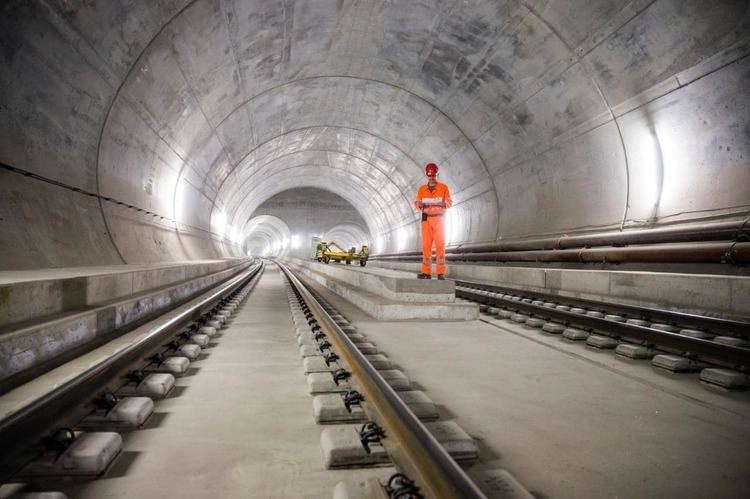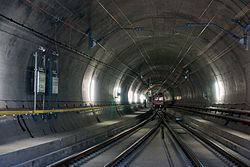Line AlpTransit | Opened 1 June 2016 | |
 | ||
Official name German: Gotthard-BasistunnelItalian: Galleria di base del San GottardoRomansh: Tunnel da basa dal Son Gottard Status Active since 11 December 2016 System Swiss Federal Railways (SBB CFF FFS) Electrified 15 kV AC railway electrification Similar | ||
The gotthard base tunnel in switzerland made in germany
The Gotthard Base Tunnel (GBT; German: Gotthard-Basistunnel, Italian: Galleria di base del San Gottardo, Romansh: Tunnel da basa dal Son Gottard) is a railway base tunnel through the Alps in Switzerland. It opened on 1 June 2016, and full service began on 11 December 2016. With a route length of 57.09 km (35.5 mi), it is the world's longest and deepest traffic tunnel and the first flat, low-level route through the Alps.
Contents
- The gotthard base tunnel in switzerland made in germany
- Background
- Description
- Construction
- Allocation of work
- Deaths during construction
- Politics
- Inauguration and commissioning
- Gottardino special trains
- Regular services
- Figures
- References
The project consists of two single-track tunnels connecting Erstfeld (Uri) with Bodio (Ticino) and passing below Sedrun (Graubünden). It is part of the AlpTransit project, also known as the New Railway Link through the Alps (NRLA), which also includes the Ceneri Base Tunnel further south (scheduled to open late 2020) and the Lötschberg Base Tunnel on the other main north-south axis. The base tunnel bypasses most of the Gotthard Railway, a winding mountain route opened in 1882 across the Saint-Gotthard Massif, which is now operating at capacity. It establishes a direct route usable by high-speed rail and heavy freight trains. It is the third tunnel connecting the cantons of Uri and Ticino after the Gotthard Tunnel and the Gotthard Road Tunnel.

The main purpose of the Gotthard Base Tunnel is to increase local transport capacity through the Alpine barrier, especially for freight, notably on the Rotterdam–Basel–Genoa corridor, and more specifically to shift freight volumes from trucks to freight trains. This not only significantly reduces the danger of fatal road crashes involving trucks, but also reduces the environmental damage caused by the ever-increasing amount of freight hauled by heavy trucks. The tunnel provides a faster connection between the canton of Ticino and the rest of Switzerland, as well as between northern and southern Europe, cutting the Zürich–Lugano–Milan journey time for passenger trains by one hour (and from Lucerne to Bellinzona by 45 minutes).

After 64 percent of Swiss voters accepted the AlpTransit project in a 1992 referendum, tunnel construction began in 1996. Drilling operations in the eastern tunnel were completed on 15 October 2010 in a breakthrough ceremony broadcast live on Swiss TV, and in the western tunnel on 23 March 2011. The tunnels' constructor, AlpTransit Gotthard AG, originally planned to hand over the tunnel to Swiss Federal Railways (SBB CFF FFS) in operating condition in December 2016 but, on 4 February 2014, the handover date was changed to 5 June 2016 with the start of an 850-day opening countdown calendar on the AlpTransit homepage. The total projected cost of the project was 9.8 billion Swiss francs (€8.85 billion, US$10.3 billion); the final cost exceeded $12 billion. Nine people died during construction.

Background

Since the 13th century, the 2,106 metre-high Gotthard Pass has been an important trade route from northern to southern Europe. Control of its access routes led to the birth of the Swiss Confederacy. The Gotthard Pass is located halfway between Lake Lucerne and Lake Maggiore. It is the shortest link between the navigable Rhine and the Po. In 1882, with the inauguration of the Gotthard Railway Tunnel, the travel time between Altdorf and Biasca was reduced dramatically, from about 30 hours (using stagecoaches) to only a few hours. This time was reduced further with the opening of the Gotthard Road Tunnel in 1980.

Today both the rail, and the road, routes are among the most important passages through the Alps on the north-south axis.
After the opening of the auto tunnel, in 1980, traffic increased more than tenfold, and the existing tunnel was at its capacity limits by 2013. A second tunnel will be built next to the first, as per a national referendum. Construction is to start in 2020 and finish in 2027.
As early as 1947, the engineer Eduard Gruner imagined a two-story base tunnel from Amsteg to Biasca, both rail and road, with a stop at Sedrun, to provide a faster and flatter passage through the Swiss Alps. Similarly to Gruner's idea, the GBT cuts through the Gotthard Massif some 600 m (2,000 ft) below the older tunnel. On the current track, the Gotthard Railway, only trains up to 1,300 t (1,400 short tons; 1,300 long tons) when using two locomotives or up to 1,500 t (1,700 short tons; 1,500 long tons) with an additional bank engine at the end of the train are able to pass through the narrow mountain valleys and through spiral tunnels climbing up to the portals of the old tunnel at a height of 1,151 m (3,776 ft) above sea level. When the GBT is in full service, standard freight trains of up to 3,600 t (4,000 short tons; 3,500 long tons) will be able to pass this natural barrier.
Because of ever-increasing international truck traffic, Swiss voters chose a shift in transportation policy in February 1994 (Traffic Transfer Act, enacted in October 1999). A second law, the Alpine Protection Act of 1994, required a shift of as much tonnage as possible from truck transport to train transport.
The goal of both the laws is to transport trucks, trailers and freight containers through Switzerland, from Basel to Chiasso, and beyond by rail to relieve the overused roads, and that of the Gotthard in particular, by using intermodal freight transport and rolling highways (where the entire truck is transported). The GBT substantially contributes to the requirements of both laws and enables a direct flat route from the ports of the North Sea (notably Rotterdam) to those of the Mediterranean Sea (notably Genoa), via the Rhine corridor.
Passenger trains can travel up to 250 km/h (155 mph) through the GBT, currently reducing travel times for trans-Alpine train journeys by about 40 minutes, and by one hour once the adjacent Zimmerberg and Ceneri Base Tunnels are completed. This is viewed as a revolution, especially in the isolated region of Ticino, which is separated from the rest of the country by the Alps and the Gotthard. The two stations of Bellinzona and Lugano (respectively named "Gate of Ticino" and "Terrace of Ticino") were entirely renovated for the opening of the GBT, among other improvements.
As of 2016, the Gotthard Base Tunnel is the longest railway tunnel in the world. It is the third Swiss tunnel to bear this title, after the Gotthard Tunnel (15 km, 1882) and the Simplon Tunnel (19.8 km, 1905). It is the third tunnel built under the Gotthard, after the Gotthard Tunnel and the Gotthard Road Tunnel.
Description
The Gotthard Base Tunnel is, with a length of 57.09 kilometres (35.47 mi) and a total of 151.84 km (94.3 mi) of tunnels, shafts and passages, the longest railway tunnel in the world, with a geodetic distance of 55.782 kilometres (34.661 mi) between the two portals. It is also the first flat route through the Alps or any other major mountain range, with a maximum height of 549 metres (1,801 ft) above sea level, corresponding to that of Berne. It is the deepest railway tunnel in the world, with a maximum depth of 2,450 metres (8,040 ft), comparable to that of the deepest mines on Earth. Without ventilation, the temperature inside the mountain reaches 46 °C (115 °F).
Like the two other tunnels passing below the Gotthard, the Gotthard Base Tunnel connects two Alpine valleys across the Saint-Gotthard Massif: the Urner Reusstal in the canton of Uri, in which flows the river Reuss, and the Valle Leventina, the largest valley in the canton of Ticino, in which the river Ticino flows. Unlike most other tunnels, the Gotthard Base Tunnel passes under several distinct mountain massifs, two of them being major subranges of the Alps, the Glarus Alps and the Saint-Gotthard Massif, with the valley of the Anterior Rhine, the Surselva in the canton of Graubünden, between them. The tunnel passes under these two ranges more than 2 kilometres (1.2 mi) below the Chrüzlistock (2,709 m (8,888 ft)) and the Piz Vatgira (2,983 m (9,787 ft), near the Lukmanier Pass). While the cantons of Uri and Ticino are part of the German- and Italian-speaking areas of Switzerland respectively, the Surselva is mainly Romansh-speaking.
The Alps strongly influence the European climate – and that of Switzerland in particular – and there can be substantially different weather conditions at each end of the GBT, described by the Ticinese architect Mario Botta: "The light changes at the Gotthard: that of the Mediterranean Sea is not the same as that of the continent, that of the central lands, that of Europe far away from the sea." On average, the temperature is 2 to 3 °C (4–5 °F) higher on the south side than the north side, but on some days, temperature differences are well over 10 °C (18 °F).
The north portal lies in the north of the municipality of Erstfeld at an elevation of 460 metres (1,510 ft), east of the Reuss. There, the tunnel penetrates the western slopes of the Bälmeten and Chli Windgällen (although only marginally) before passing below the valley of the Chärstelenbach, a creek in the Maderanertal. From there, the tunnel runs parallel to the small valley of Etzli, below the Witenalpstock. The main crest of the Glarus Alps, which is the watershed between the Reuss and the Anterior Rhine, is crossed below the Chrüzlistock, the crest having an elevation of about 2,700 metres (8,900 ft) at this point. From the crest and border, the tunnel runs parallel to the small valley of the river Strem (Val Strem) before passing below Sedrun and the Anterior Rhine. From the bottom of the valley, the tunnel proceeds towards the valley of the Rein da Nalps (Val Nalps) and passes east of Lai da Nalps, before crossing the Gannaretsch range below the western summit of Piz Vatgira (2,981 metres (9,780 ft)). This is the deepest point of the tunnel, with a rock layer of 2,450 metres (8,040 ft) above it. The tunnel then passes below the valley of the Rein da Medel (Val Medel) and west of Lai da Sontga Maria. After a few kilometres the tunnel crosses the watershed between the Anterior Rhine and the Ticino, just north of Pizzo dell'Uomo (2,525 metres (8,284 ft)). This point corresponds to the main chain of the Alps, and is the main drainage divide between the Rhine and the Po. For a few kilometres, the tunnel passes below two western tributaries of the Brenno in the Valle Santa Maria before crossing the last range, west of the Passo Predèlp (about 2,500 metres (8,200 ft)) and east of Faido. It then follows the eastern slopes of the large Valle Leventina, the valley of the Ticino, for about 18 kilometres (11 mi) to the south portal at Bodio, at an elevation of 312 metres (1,024 ft), just 3 kilometres (1.9 mi) before Biasca, where the Brenno converges with the Ticino.
The closest railway stations to the portals are Altdorf and Biasca. The first regularly served railway stations on the base line (as of 2016/17) are those of Arth-Goldau (Schwyz), a railway node with links to Lucerne and Zürich, and Bellinzona (the "Gate of Ticino"), with links to Locarno, Luino and Lugano (via the Monte Ceneri Rail Tunnel). The journey from Arth-Goldau to Bellinzona takes not more than an hour. The station of Altdorf is planned to be served by 2021. There also have been talks of using that of Biasca. The travel between Altdorf and Biasca would last less than 25 minutes.
Construction
AlpTransit Gotthard AG was responsible for construction. It is a wholly owned subsidiary of the Swiss Federal Railways (SBB CFF FFS).
To cut construction time in half, four access tunnels were built so that construction could start at four different sites simultaneously: Erstfeld, Amsteg, Sedrun, and Faido. A fifth at Bodio was added later. The two tunnels are joined approximately every 325 m (1,066 ft) by connecting galleries. Trains can move between the tunnels in the two multifunction stations at Sedrun and Faido. These stations house ventilation equipment and technical infrastructure and serve as emergency stops and evacuation routes.
Access to the Sedrun station site is by a level access tunnel 1 km (0.6 mi) long from the valley floor near Sedrun. At the end of the access tunnel, two vertical shafts lead 800 m (2,625 ft) down to the base tunnel level. A proposal to construct a functioning railway station, called Porta Alpina (from Romansh, "Alpine Gate"), at this site was evaluated, but the project was put on hold in 2007 and definitively cancelled by the federal authorities in 2012 as uneconomical.
The final breakthrough in the east tube occurred on 15 October 2010 at 14:17 +02:00. The final breakthrough in the west tube occurred on 23 March 2011 at 12:20.
On 30 August 2013, the tunnel was entirely traversed for the first time from Bodio to Erstfeld in six hours, by diesel train, buses and by foot.
On 16 December 2013, the operational test phase started on a 13-kilometre (8.1 mi) stretch in the southern section of the west tube between Faido and Bodio. Its purpose was to test the infrastructure and any ancillary systems.
On 31 October 2014, the railway track installation was completed. A gold sleeper on the very last part of the track was installed during the event to mark this milestone of progress.
On 1 October 2015, following the permission by the Federal Office of Transport, the first tests on the entire length of the GBT were performed, with steadily increasing speed. On 8 November, a train reached the top speed of 275 km/h.
Allocation of work
The contracts were awarded in sections:
Deaths during construction
Nine workers lost their lives during construction; one in the Amsteg section, two in the Sedrun section, and three each in the southernmost Faido and Bodio sections. These were:
Politics
The realization of the GBT, as the centrepiece of the NRLA, is also a prototypical example of direct democracy in Switzerland. In order to accomplish this mega-project the political institutions also had to overcome many parliamentary sessions and several major popular votes, including the following:
Inauguration and commissioning
In 2016, several events, including festivities and special exhibitions, were held around the Gotthard. These culminated at the inaugurations in early June, dubbed Gottardo 2016. Many public institutions joined the celebrations, such as Swiss Post, which produced a special stamp for the Gotthard Base Tunnel, and Swissmint, which issued gold and silver coins dedicated to the opening.
On 31 May 2016, a day before the inauguration, the nine people who died during construction were commemorated in a ceremony at the north portal in Erstfeld that was led by a Catholic vicar general, a vicar of the Evangelical-Reformed Church of Uri, a Jewish rabbi, and a Muslim imam. A bronze memorial plaque with their names — four coming from Germany, three from Italy, and one from each of South Africa and Austria – was unveiled by AlpTransit Gotthard CEO Renzo Simoni. A Catholic shrine to Saint Barbara, the patron of miners, stands inside the tunnel as a memorial.
The tunnel was officially inaugurated on 1 June 2016. At the northern entrance in Erstfeld, President of the Confederation Johann Schneider-Ammann spoke of a "giant step for Switzerland but equally for our neighbours and the rest of the continent", while a live relay carried a speech given by Transport Minister Doris Leuthard at the southern entrance in Bodio. The first journey carried hundreds of Swiss citizens who had won tickets in a draw, while the assembled guests in Erstfeld, including the Federal Council in corpore, heads of state and government from neighbouring countries and transport ministers from European countries, attended the opening show Sacre del Gottardo by Volker Hesse featuring dancers, acrobats, singers and musicians celebrating Alpine culture and history. On the following weekend, popular festivities and special exhibitions, attended by more than 100 000 visitors, were held.
Gottardino special trains
From 2 August to 27 November 2016, the Swiss Federal Railways ran a special train service through the tunnel called "Gottardino" which was open to the public. It was a once-daily service from Flüelen railway station to Biasca railway station and in reverse. The trains make a stop inside the tunnel to allow passengers to visit an exhibition inside an underground multifunction station in Sedrun which would normally be used in emergency only.
Regular services
In the year 2016, the GBT was tested extensively before its integration into the regular schedule on 11 December. On 5 December, the Swiss Federal Railways were granted permission from the Federal Transport Office to use the new base line. While the base tunnel is used for InterCity trains (ICN) and EuroCity trains (EC), the summit line remains in use for regional trains.
